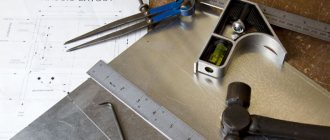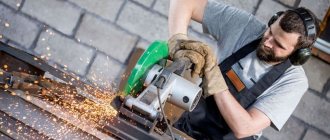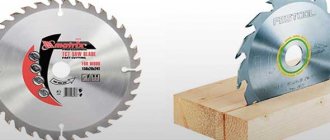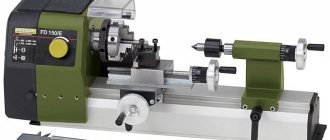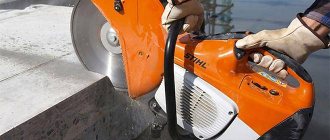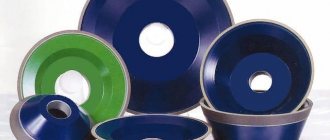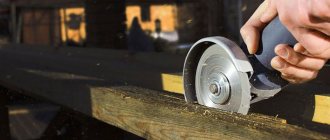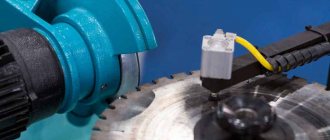The variety of work performed with the help of grinders is largely ensured by the wide range of tools that work with them.
For each standard size angle grinder, you can always select consumables that correspond to the characteristics and dimensions. One of the parameters that determines the capabilities of an angle grinder is the maximum diameter of the disk that is installed on it. It determines the speed, engine power and torque. The choice of disk size is closely related to the nature of the work performed by the grinder.
Types of circles
The circles (disks) of grinders differ according to the following indicators:
- work performed that determines the purpose of the tool;
- composition of the material;
- dimensions.
Technological features
The necessary processing technology is provided by the following consumables.
- — Cutting wheels. Mainly used for processing metals, less often for other types of materials.
- — Grinding wheels. Different designs allow you to perform both roughing or cleaning, and bringing the surface roughness to the desired condition.
- — Polishing discs and attachments. Bring the surface to a shine using felt or other fabric with similar properties.
By material
The operating modes are influenced by the material component from which the tool is made.
- — Abrasive disc. The basis that served for the manufacture of the tool is the abrasive material itself, a binder, for example, bakelite and various fillers. Mainly used for metal processing.
- — Diamond wheel (with diamond coating). With its help, you can process materials of any strength (various types of stone, ceramics, quartz glass and many other similar ones consisting of solid fractions).
Dimensions
The main classification criterion here is the diameter of the disc. The depth of the cut depends on its size (it is approximately a quarter of the diameter). The functionality of an angle grinder is determined by the size of the tool: a small diameter makes it possible to process a light angle grinder in hard-to-reach places, while a larger size angle grinder with greater productivity will be difficult and unsafe to hold “in weight”.
Grinding
Grinding wheels are used for polishing concrete, metal and wooden surfaces for painting or priming. Attachments for circles can be made of sandpaper, felt and even felt. In turn, the design of sanding wheels can be petal or flat (put on a wheel).
Each grinding disc has its own grit size. It is selected depending on the work being performed. Below is a table for selecting wheel grit depending on the type of grinding:
| Types of grinding | Recommended grit number |
| Flat | 16 — 36 |
| Round roughing | 24 — 36 |
| Round finishing | 60 — 100 |
| Finishing a multi-blade tool | 170 — 220 |
| Finishing | 180 — 320 |
| Thread grinding | 100 — 280 |
Marking
The choice of the right tool is facilitated by the presence of markings. It contains the technical parameters of consumables in encrypted form. For example, this is what an alphanumeric set of markings for a cutting disc looks like, produced by a Russian manufacturer:
- — The image shows the tool manufacturer — Luga Abrasive Plant (Luga, Leningrad Region).
- — Tool name:
- cutting wheel - in Russian;
- cut –off – wheel – in English translation.
- — Purpose: for processing steel (inscriptions “steel”, “steel” on the circle).
- — The dimensions of the circle are indicated (outer diameter x thickness x bore diameter):
- in mm – 200 x 2.5 x 22.23;
- in inches – 8”x 1/10”x 7/8”;
- digital designation "41". This is a characteristic of the design of the circle - here it is flat.
- — The circle is designed for 7650 rpm, while the maximum peripheral speed should not exceed 80 m/s.
- — Technical parameters of the wheel material are determined from the designation “A 30 S BF”, where:
- A – means that the abrasive is based on white electrocorundum, which is specifically used for metal processing;
- 30 – abrasive grain size, here it is average;
- S – hardness of the circle, here the circle is hard;
- BF - denotes the type of bond, here synthetic resins with glass fiber reinforcement.
- — Rules for safe work in the form of signs indicating the required action.
- - GOST 21963 - 2002, GOST R 52588 - 2011, EN 12413 - Russian and European regulatory documents to which this tool complies.
The marking of a foreign manufacturer of tools for angle grinders is as follows:
- — Tools under the NORTON VULKAN brand are produced by the Saint Gobain corporation, headquartered in France.
- —The purpose of the cutting disc (the company produces only such a tool for angle grinders) for processing steel (in addition, for visualization purposes, the label for wheels intended for metal processing is blue) is duplicated in several languages.
- — The circle is designed for 12250 rpm with a maximum peripheral speed of 80 m/s.
- — The dimensions are the same as on the Russian disk - in mm and inches.
- — The digital designation “41” has been added to the technical parameters of “A60S – BF41”. This is a characteristic of the design of the circle - here it is flat.
- — Methods of safe work must be indicated.
- — The regulatory documents to which the instrument complies are issued by the European Union.
Influence of hardness characteristics
The disc models under consideration have different hardness, which will depend on the material of manufacture. When selecting a nozzle according to this parameter, you should be guided by a simple rule - the harder the material you plan to process, the less hard the material used to make the equipment used should be. As a striking example, the following advice can be given: to cut/sawing cast iron, metal or steel, you should use electrocorundum equipment. But for cutting aluminum, copper or stainless/galvanized steel, you can get by with a silicon carbide nozzle. In addition, it should be remembered that the hardness of the disk will also be affected by the size of the grains - this parameter is indicated on the front side of the circle and is marked with the letters “M” and “T” (“soft” and “hard”, respectively).
IMPORTANT! It is also necessary to pay attention to the “hardness index”, which is indicated by two numbers after the corresponding letter. Thus, the higher the number, the higher the hardness.
What are the sizes of wheels for angle grinders Bosch, Interskol and more?
Almost all large companies produce grinders covering the maximum number of works - from household to industrial designs. Each type has its own tool size. In addition to the production of angle grinders, such manufacturers (Bosch, Metabo, Interskol and others) have mastered the parallel production of consumables. They select a special composition and standard size of consumables in order to maximize the operating efficiency of the specific model they produce.
Outer and bore diameter, maximum and minimum value
The most popular range of angle grinder sizes consists of the following values.
External diameter . The most preferred sizes are: 115 mm, 125 mm, 150 mm, 180 mm, 200 mm and 230 mm. In rare cases, to perform, for example, jewelry work with small parts, portable battery-powered angle grinders with diameters of 76 mm or 100 mm are used.
The minimum diameter of 115 mm is used for simple work in the form of processing hard-to-reach surfaces in the household. Anglers with a circle with a diameter of 125 mm have greater ability to perform various household works.
The diameter of 230 mm is used in the professional context of angle grinders for large volumes of work, for example, in construction. Circles with a diameter of more than 230 mm are installed on stationary equipment.
Thickness _ Cutting wheels are available in thicknesses from 0.8 mm to 5.0 mm. Moreover, a larger diameter should have a circle with a correspondingly greater thickness.
You should know! A thin disc is easy to cut, but it is also more likely to break.
Landing diameter . The standard mounting diameter for angle grinder consumables is 22.23 mm. In the vast majority of cases, it is the same for all disk sizes. It is rare to find mounting diameters of 10 mm, 13 mm, 16 mm due to the limited use of angle grinders with a diameter smaller than 100 mm. A 32 mm bore diameter is used with circles of 300 mm and larger on stationary equipment.
Compliance with safety regulations
Any construction work requires attention, accuracy and professionalism. There are safety rules when working with angle grinders, which should not be neglected. The main list of requirements is as follows:
- Remove all flammable and combustible materials away from the workplace.
- Protect your face with a special shield.
- Correctly set the wheel rotation speed based on the type of material being processed.
- Work exclusively with whole wheels that have not yet expired.
- Hold the grinder in such a way that the rotation of the attachment is carried out by the master. If the disc gets jammed, it will not bounce off and cause bodily harm to a person.
For large, medium and small angle grinders
The power classification into small, medium and large is closely related to dimensions and weight. The greater the power, the greater the weight and overall dimensions.
So, for example, grinders with disks of 115 mm - 125 mm and a power of 0.6 kW to 1.2 kW are classified as small equipment.
Angler grinders with discs of 150 mm - 180 mm and a power of up to 2.0 kW belong to the middle class of such equipment.
Professional angle grinders with a power of up to 3.0 kW and a disc diameter of 230 mm conventionally belong to large angle grinders.
Popular models
Let's consider the most popular models of disks for angle grinders:
BOSH
One of the most famous and reliable manufacturers of equipment and accessories. The disks of this company demonstrate high reliability, durability, and resistance to all loads;
INFORCE
A tool from a domestic manufacturer that demonstrates high performance, durability, a wide range of types and sizes. It has an optimal price-quality ratio;
KLINGSPOR
A German company approaching its 130th anniversary. The accumulated technological experience allows us to produce discs that demonstrate exceptional durability and strength. According to user reviews, nozzle wear is insignificant even after prolonged processing of the most problematic materials. The cost of the tool is quite high;
3M
An American company that produces a wide range of abrasive and polishing materials and accessories for various equipment. It was this company that took the lead in the discovery of corundum as an abrasive material. Products manufactured by 3M are distinguished by high quality, durability, and the absence of geometric deviations;
METABO
A trademark owned by Metabowerke GmbH (Germany). There is no point in talking about the quality and reliability of German technology for a long time; they are the standard for all manufacturers. Wheels for angle grinders produced under the METABO brand belong to the group of professional tools. According to experts and ordinary users, these attachments are practically free of drawbacks;
HITACHI
A Japanese company supplying high-quality technological equipment, tooling and tools to the world market. There are wheels on the market under the “HITACHI” brand, manufactured in Luga. They demonstrate quite decent qualities, are accurate, and durable. Relatively low cost;
Luga-Abrasiv
Domestic manufacturer of cutting and other attachments for angle grinders. The combination of price and quality allows us to consider these attachments as one of the most popular on the market, and user reviews are almost all positive;
Bison
Russian company producing power tools and consumables. Offers a wide range of attachments for angle grinders, characterized by affordable prices and high quality.
The list of manufacturers does not end there; they can be listed for a long time. Modern production technologies make it possible to produce strong, durable discs that demonstrate high quality, efficiency and precision in operation.
For metal, concrete, wood and other materials
To effectively process any material, it is important to choose the right power so that it matches the diameter of the tool and its thickness. In addition, the consumable must have suitable characteristics for processing a specific type of workpiece material.
The main difference between discs for steel, cast iron, and non-ferrous metals is in the composition of the fillers. To process alloy steels, a very strong additive is added to the disc material that can overcome the resistance of alloy steel. When processing non-ferrous metals, on the contrary, a soft filler is added, which works effectively when processing viscous materials.
Disc for aluminum
To process concrete (tiles, paving slabs), diamond discs are used (actually, these are metal circles coated with diamond).
Tile disc
It is not recommended to process wood with an angle grinder due to the high risk of injury. If such a need nevertheless arises, then the best option would be a grinder with a disk with a diameter of 125 mm. As a working tool, special angle grinder discs for wood should be used.
Wood disc
Cutting discs
Cutting discs are most often used when working with an angle grinder. The following nozzles are distinguished by purpose:
- For metal. Such cutting wheels are made from electrocorundum or crystalline corundum. In this case, a bakelite bond is often used inside the product. Depending on the thickness and size, the disc can cut metal profiles, stainless steel, heating pipes, etc. GRAFF GADM 115 10 is one of the representatives of inexpensive metal discs.
- For stone and concrete. Circles for cutting stone and concrete are made of silicon carbide. Please note that the disc is intended for relatively “soft” materials, such as white brick and slate (harder ones will require a diamond wheel).
- For ceramic tiles and concrete. This attachment is designed for cutting paving stones, ceramic tiles, red bricks, cutting strips for gating, etc. The disc itself is made of metal with diamond chips applied to the cutting edge. There are solid all-metal and segmented discs. The first ones are intended for wet cutting (cooling with water), as they become very hot during the process. Segmented ones are convenient for dry cutting, and they are the most popular among diamond blades. Here, for example, is a high-quality, durable segmented disk Makita B-28086 for cutting concrete and stone products.
- For wood . Discs for processing wooden structures are made of tungsten carbide or metal with abrasive coating. The first ones are designed for cutting hard and soft wood, plasterboard, gas silicate and MDF. The second one can also cut metal and even wood with nails (but this needs to be checked experimentally). Bison Professional 36859-125 is just such a representative of the “nail saw”.
- Universal. These attachments can cut almost all types of materials (for wood, it is better to take a direct-use attachment). In particular, they are convenient to use when you have to cut different materials in one working day, and you don’t want to waste time changing the nozzle. Universal models even cut reinforced concrete. However, they are often quite expensive, and sometimes it is more profitable to buy two disks for different types of materials being processed. Of the good universal circles, we can recommend Wolverine 100125, which is suitable for both wet and dry cutting.
How to choose
The main criterion for choosing the disk size will be the nature of the work performed. In the household, these will be circles of smaller diameters; in a production environment, a tool of large diameter (230 mm) is used.
In addition to the dimensional characteristics, you should carefully check the compliance of the disc material with the material of the workpiece being processed.
Another determining factor is the power of the grinder. It is directly related to the weight and overall characteristics of an angle grinder. With approximately the same characteristics, preference should be given to a lighter specimen.
How to replace
The grinder disc is a consumable item. Therefore, it has to be changed frequently. There is a simple algorithm in which an important role is played by the original design of the key supplied to the consumer along with the grinder.
- — The protruding rods of a special key are installed in the grooves of the fastening nut.
- — At the same time, press the lock button located on the gearbox housing. It will lock the rotor from turning.
- — Turn the key counterclockwise to release the fasteners of the worn disk.
- — The old disk is replaced with a new one of the same technical characteristics and size. The new disk is installed with the markings facing out to remind you of the disk parameters and for other good reasons (see explanation in the video above).
- — The fastening nut is first tightened by hand and finally tightened with a special wrench.
The Bulgarian is ready to continue fulfilling its functional purpose.
